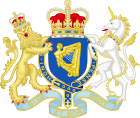Banishment Act facts for kids

Parliament of Ireland
|
|
| Long title | An Act for banishing all Papists exercising any Ecclesiastical Jurisdiction, and all Regulars of the Popish Clergy out of this Kingdom |
|---|---|
| Citation | 9 Will 3 c.1 |
| Introduced by | Murrough Boyle, 1st Viscount Blesington |
| Dates | |
| Royal assent | 25 September 1697 |
| Repealed | 13 August 1878 |
| Other legislation | |
| Repealed by | Statute Law Revision (Ireland) Act 1878 |
|
Status: Repealed
|
|
| Text of statute as originally enacted | |
The Banishment Act (also known as the Bishops' Banishment Act) was an important law passed in 1697 by the Parliament of Ireland. This Act made it illegal for certain Catholic leaders and religious groups to stay in Ireland. It ordered all Catholic archbishops, bishops, deans, Jesuits, monks, friars, and other regular Catholic clergy to leave the country by May 1, 1698.
If these religious leaders did not leave, or if they tried to return, they would face serious punishments. For a first offense, they could be put in prison for 12 months and then forced to leave. If they broke the law a second time, it was considered a very serious crime against the government.
Contents
Why the Banishment Act Was Passed
This Act was part of a series of laws called the Penal Laws. These laws were put in place after a conflict known as the Williamite War in Ireland. The main goal was to protect the Church of Ireland as the official church. There were also worries that Catholic clergy might support Jacobitism, which was a movement to bring back the old royal family to the throne.
Earlier Attempts to Ban Clergy
Before the Banishment Act, there were similar attempts to remove Catholic clergy. The government in Dublin had issued official announcements in 1673 and 1678 with similar rules. These showed that the idea of banning Catholic clergy had been around for a while.
How the Act Affected Clergy
The Banishment Act was most effective at first against "regular clergy." These were priests who belonged to religious orders like Jesuits, monks, and friars. Many of them tried to avoid being sent away by registering as "parish priests" under a different law passed in 1704. Parish priests were treated differently and could sometimes stay.
The ban on bishops was meant to stop new priests from being ordained (officially made priests). If no new priests could be trained and no priests could enter the country, it was hoped that the Catholic clergy would eventually disappear from Ireland.
What Happened to the Bishops and Priests
When the Act was passed, there were eight Catholic bishops in Ireland. Two of them left the country. One bishop, John Sleyne, was arrested. The other five went into hiding to avoid being caught.
Records show that the port authorities paid for 424 clerics to leave Ireland. It is believed that around 700 Catholic clergy left in total, with about 400 settling in France. In the years that followed, people known as "priest hunters" actively searched for any Catholic priests who remained in Ireland. For example, Maurice Donnellan, who was the Catholic Bishop of Clonfert, was arrested in 1703. However, a group of armed people rescued him.
Changes and End of the Act
As the 1700s continued, the Banishment Act was not enforced as strictly. Over time, the rules became less harsh.
Later Laws Affecting the Act
In 1782, a new law called the Roman Catholic Relief Act 1782 was passed. This law stated that the Banishment Act's rules would not apply to a priest who had registered and taken a special "oath of supremacy." This oath was a promise of loyalty to the British monarch.
When the Act Was Officially Ended
The Banishment Act was finally and officially removed from law in 1878. This happened when the Statute Law Revision (Ireland) Act 1878 was passed.

